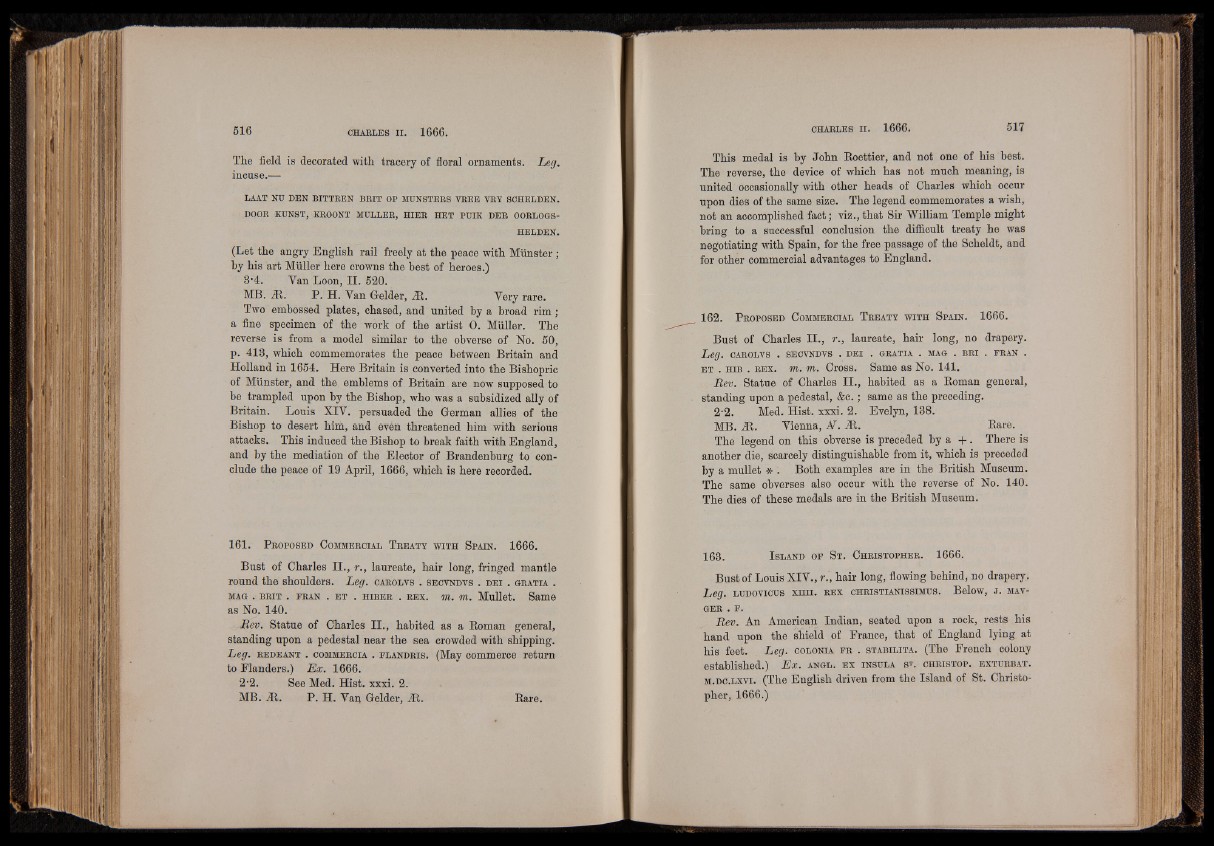
The field is decorated with tracery of floral ornaments. Leg.
incuse.—
LAAT NU DEN BITTEEN BEIT OP MTJNSTEBS VEEE VRY SCHELDEN.
DOOE KUNST, KKOONT MULLEE, HIEE HET PUIK DEE OORLOGSHELDEN.
(Let the angry English rail freely at the peace with Miinster;
by his art Müller here crowns the best of heroes.)
3'4. Yan Loon, II. 520.
MB. JR. P. H. Yan Gelder, 51. Very rare.
Two embossed plates, chased, and united by a broad rim ;
a fine specimen of the work of the artist 0. Müller. The
reverse is from a model similar to the obverse of No. 50,
p. 413, which commemorates the peace between Britain and
Holland in 1654. Here Britain is converted into the Bishopric
of Münster, and the emblems of Britain are now supposed to
be trampled upon by the Bishop, who was a subsidized ally of
Britain. Louis XIV. persuaded the German allies of the
Bishop to desert him, and even threatened him with serious
attacks. This induced the Bishop to break faith with England,
and by the mediation of the Elector of Brandenburg to conclude
the peace of 19 April, 1666, which is here recorded.
161. P e o p o s e d C om h e e c ia l T e e a t y w it h S pa in . 1666.
Bust of Charles H., r., laureate, hair long, fringed mantle
round the shoulders. Leg. cabolvs . secvndvs . d e i . grat ia .
mag . b e it . e e a n . e t . HiBEE . r e x . m. m. Mullet. Same
as No. 140.
-Rev. Statue of Charles II., habited as a Roman general,
standing upon a pedestal near the sea crowded with shipping.
Leg. e e d e a n t . commercia . FLANDRis. (May commerce return
to Flanders.) Ex. 1666.
2-2. See Med. Hist. xxxi. 2.
MB. JR. P. H. Van Gelder, JR. Rare.
This medal is by John Roettier, and not one of his best.
The reverse, the device of which has not much meaning, is
united occasionally with other heads of Charles which occur
upon dies of the same size. The legend commemorates a wish,
not an accomplished fact; viz., that Sir William Temple might
bring to a successful conclusion the difficult treaty he was
negotiating with Spain, for the free passage of the Scheldt, and
for other commercial advantages to England.
162. P r o po s ed C omm er c ia l T r ea ty w it h S pa in . 1666.
Bust of Charles II., r., laureate, hair long, no drapery.
Leg. CAEOLVS . SECVNDVS . DEI . GRATIA . MAG . BEI . FEAN .
e t . h ib . r e x . m. m. Cross. Same as No. 141.
Rev. Statue of Charles II., habited as a Roman general,
standing upon a pedestal, &c.; same as the preceding.
2-2. Med. Hist. xxxi. 2. Evelyn, 138.
MB. 5 t. Vienna, N . JR. Rare.
The legend on this obverse is preceded by a + . There is
another die, scarcely distinguishable from it, which is preceded
by a mullet * . Both examples are in the British Museum.
The same obverses also occur with the reverse of No. 140.
The dies of these medals are in the British Museum.
163. I s l a n d o f St. C h r i s t o p h e r . 1666.
Bust of Louis XIV., r., hair long, flowing behind, no drapery.
Leg. lu d o v ic u s x h i i . r e x c h r is t ia n is s im u s . Below, j . mav-
GER . F.
Rev. An American Indian, seated upon a rock, rests his
hand upon the shield of France, that of England lying at
his feet. Leg. colonia f r . s t a b il it a . (The French colony
established.) Ex. a n g l . e x in su l a s t . c h r is t o p . ex t u r b a t .
m .dc .l x v i . (The English driven from the Island of St. Christopher,
1666.)